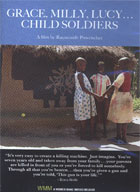
Grace, Milly, Lucy … Child Soldiers 2010
Distributed by Women Make Movies, 462 Broadway, New York, NY 10013; 212-925-0606
Produced by Macumba Doc and the National Film Board of Canada
Directed by Raymonde Provencher
DVD, color, 72 min.
Jr. High - General Adult
Uganda, Human Rights
Date Entered: 09/23/2011
Reviewed by Christopher Lewis, American University Library, American UniversityIn Northern Uganda, The Lord’s Resistance Army (LRA), an apocalyptic Christian military group led by Joseph Kony, has been leading a rebellion against the Ugandan government since the 1980s. Over time its ranks have been sustained by the kidnapping and indoctrination of children. These children, both boys and girls, under threat of death to themselves or their families and friends are converted to gun-toting soldiers very quickly. According to the film, 30% of the child soldiers are girls and young women. The film profiles three women who managed to escape and are now reaching out to others to help repair damaged lives. According to the film, women have been overlooked in the international media’s focus on this problem and Grace, Milly, Lucy tries to remedy that.
Of the three women, Grace was captive for seven months and clearly seems to be recovering. She’s a spokesperson on the issue of child soldiers and is living in the U.S. and attending college. Milly and Lucy were both abducted at the age of nine and held captive for ten years. They are back in their villages and have much to overcome. The LRA has had a history of atrocities including the mass murder of innocents. Both women are also raising children that resulted from rapes, in Lucy’s case when she was 13. Milly is now married to a supportive husband and appears to be coping with her past and her children are adjusting. Lucy, on the other hand, is haunted. She is depressed and has been ostracized by the community, coping with a reputation of cruelty toward fellow captives she displayed in the LRA. Both women devote time to a local organization called “Empowering Hands” a support group that helps rehabilitate child soldiers. All three portraits are very intimate and moving. The situation remains tragic and the film brings needed attention to it.
The production quality and narrative structure of the film are both excellent.
The film is recommended with one caveat. There are already several earlier documentaries on child soldiers in the LRA including Soldier Child (1998), Uganda: The War of Children (1999), Invisible Children (2003), and Uganda Rising (2006) and though they may not directly address the need to rehabilitate female child soldiers the impact on captured girls and women is not overlooked.